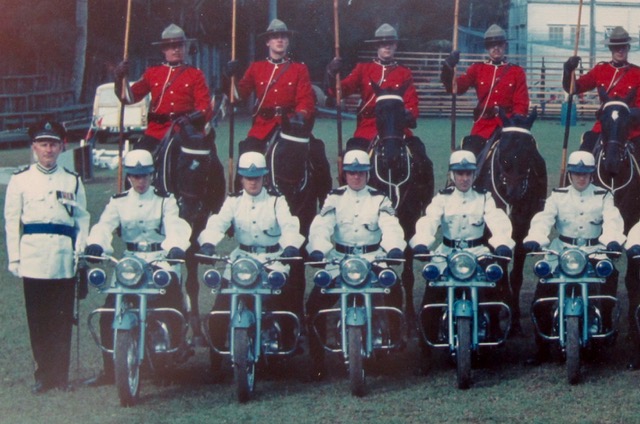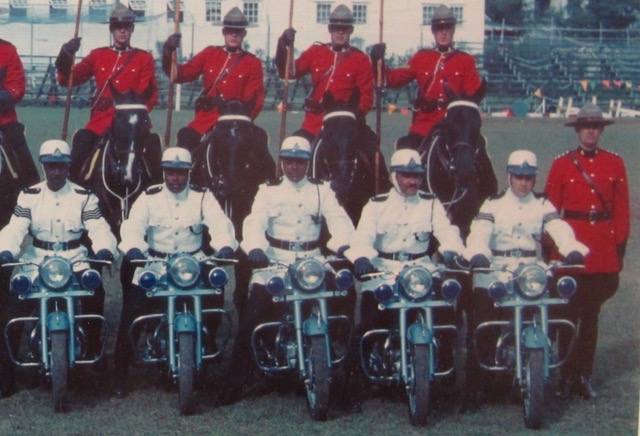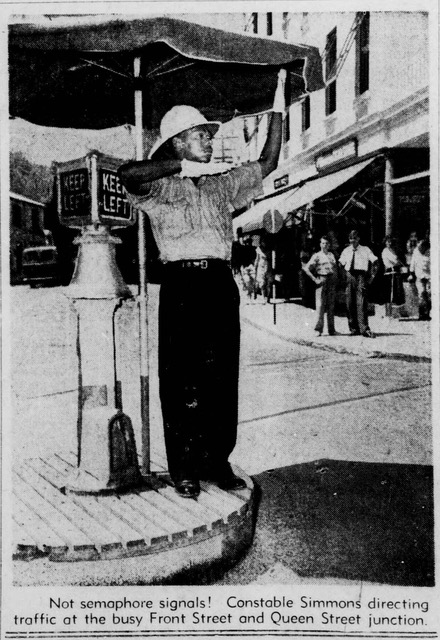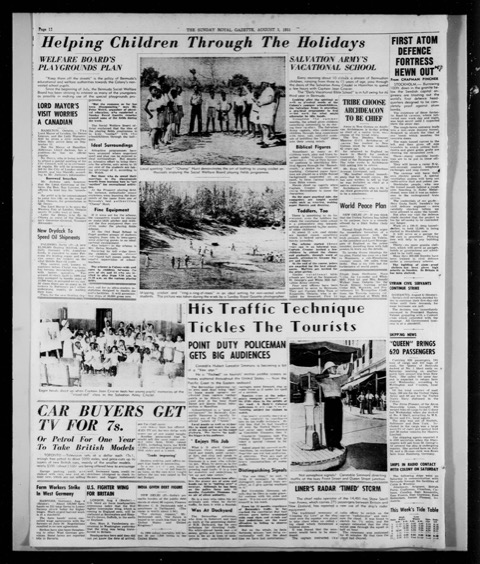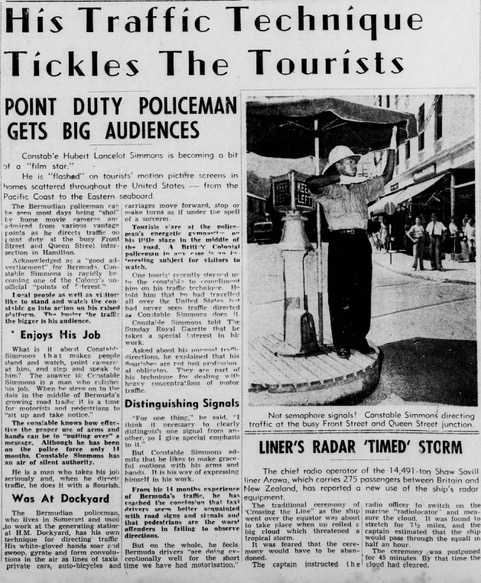We recently published the following photos in the "Who, Where and When" column of our ExPo website. The event was a once-in-a lifetime display in Bermuda by the Royal Canadian Mounted Police, together with a display by our own Bermuda Police Motor Cycle Display Team, which was held at the BAA Field in October 1969.
This spectacular exhibition was hosted by the Bermuda Horse and Pony Association on the occasion of the Association’s Annual Show.
It was first time the Mounted Police had ever performed in a British Colony and also the first occasion for which they transported their horses by air. This was in itself quite a feat; three specially chartered aircraft carried the horses, each in an individual stall, from Washington, where The Ride had concluded its United States Tour, to Bermuda.
We had asked our ExPo website readers to identify the 10 police officers who made up the Motor Cycle Display team together with the senior officer who was instrumental in supporting their creation. We have provided the names of the police officers below, and we would love to be able to name all of the RCMP members if anyone can assist.
In researching the details of this memorable visit by the RCMP we discovered that the photograph was featured on the front cover of our Police Magazine, Spring edition, 1969. Fortunately, there was an excellent article in the magazine, written by then Inspector JCP Hanlon providing fascinating details of this unique visit by the RCMP, which is re-printed below.
A team of volunteer police motor cyclists had been formed in 1961, and was initially responsible for providing motor cycle escorts for His Excellency the Governor, Major-General Sir Julian Gascoigne, on offcial occasions. Chief Superintendent Frank Williams was very keen to have police motor cyclists providing a professional image. Mr. Williams obtained a training programme used by the London Metropolitan Motorcycle Precision Riding Team, and he proposed the formation of a volunteer team of Bermuda Police motor cyclists. CLICK HERE to view our article on the History of the Police Motor Cycle Display Team written by Sgt George Goddard. The team quickly became an exceptionally popular attraction at many social events, including the Annual Agricultural Show in the Botanical Gardens, throughout the 1960's and 1970's.
Royal Canadian Mounted Police Musical Ride and
Bermuda Police Motor Cycle Display Team
performed at BAA Field in November 1968
Police Officers
(l-r) DCOP Frank Williams (standing) Denis Brookes,
Richard "Dick" Johnson, Tim Willis, Tom Cassin, Alec Forbes
(l-r) Gerald "Gerry" James, Campbell Simons, Custerfield "Custy" Crockwell,
Eddie "Boxhead" Foggo and Harold Moniz
THE ROYAL CANADIAN MOUNTED POLICE
MUSICAL RIDE
by J. C. P. Hanlon
One of the most colourful displays of horsemanship ever seen in the Colony was presented by the Bermuda Horse and Pony Association in November 1968. The occasion was the Association’s Annual Show and the display was given by the Royal Canadian Mounted Police Musical Ride.
This was the first occasion on which the Mounted Police had performed in a British Colony and also the first occasion on which they transported their horses by air. This was in itself quite a feat; three specially chartered aircraft carried the horses, each in an individual stall, from Washington, where The Ride concluded its United States Tour, to Bermuda. The advance unit, commanded by Staff Sergeant H. C. M. Armstrong, arrived on the evening of 4th November and the main body on the afternoon of the 5th. Sub-Inspector P. J. C. Morin, an officer of twenty years service, was in command of The Ride. The members were billeted at the Police Single Mens Quarters at Prospect and the horses in specially constructed stables at the Bermuda Athletic Association’s gymnasium near the field where the event was being held.
On 6th November the RCMP personnel were guests at a cocktail party hosted by the Police Recreation Club to introduce them to members of the Bermuda Police and ex-RCMP members who are resident in the Colony. Parents and relatives of serving RCMP personnel were also present for the occasion.
The Horse Show was unfortunately plagued by inclement weather. This did not, however, result in any cancellation of the performances, although it did discourage many would-be spectators. Heavy rains made the B.A.A. Field hazardous for the intricate manoeuvres which formed part of the display. – It also introduced fresh hazards for the Bermuda Police Display Team. Fortunately the skill and precision of the Mounties and local Police prevented any accidents occurring.
The first show on the afternoon of Saturday, 9th November, was probably the most colourful. The elements were favourable, blue skies, white clouds and sunshine provided an ideal background for the colourful uniforms of The Ride. Dressed in the familiar scarlet tunics, blue-black breeches with yellow Cavalry stripe, brown riding boots and Stetson hats and carrying lances, the Mounties, riding their all-black steeds, presented a magnificent sight as they entered the arena led by Sub-Inspector Morin.
Following the March Past, the Mounties entered into the various and intricate manoeuvres for which they have become renowned.
Each figure was executed with the precision and expertise which only comes from extensive and arduous training. The horses displaying the maple leaf emblem on their flanks, kept perfect time to the music of the Bermuda Regiment. With arched necks and prancing steps the animals went through each sequence with a precision and smoothness which seemed to indicate that they knew exactly what was required of them and did not need the quiet and imperceptible commands of their riders. Having performed the various figures, outlined in more detail later in this article the display concluded with The Charge. The sight of the Mounties charging at full gallop, lances at the ‘advance’ position, probably the most spectacular of all the movements , captivated the audience evoking as it did an image of the distant past when the pitifully small band of ‘Scarlet Riders” brought law and order to the wild and vast Dominion of Canada.
Children and adults alike flocked to the stables after each performance to watch the troopers groom their mounts and to have their Photographs taken standing beside a red-coated Mountie. The imposing 6' 4”, impeccably turned-out figure of the Riding Master, Staff-Sergeant Armstrong, with clipped moustache and riding Crop, was much in demand by the camera enthusiasts.
During the performances the Salute was taken at the March Past by various local dignitaries, including Mr. F. B. Williams, the then Acting Commissioner of Police. A former Chief Superintendent of Bermuda Police, Mr. C. W. Pantry, whose son Louis is an Inspector in the RCMP, was invited to attend the afternoon performance on Armistice Day. Despite a severe back complaint he attended, accompanied by his gracious wife and was accorded a special welcome by Staff Sergeant Armstrong who acted as commentator during the display.
During the course of their tour the members of The Ride attended at Government House where they were inspected and entertained by His Excellency the Governor.
All members of The Ride are regular police officers and, apart from certain of the
Instructors are only seconded to the Mounted Section for a two year period. On their return to Canada half of the members were posted back to regular duties and fresh replacements were taken in for a two year tour of duty, thus ensuring that The Ride has a hard core of experienced riders at any time. The Ride’s next foreign appearance will be a four month tour of cities in the United Kingdom, commencing on 2nd May and concluding on 7th September at the Edinburgh Tattoo.
It is felt that the background and history of The Ride will prove of interest to readers-
The author is indebted to the Royal Canadian Mounted Police for details of this history and for the black and white photographs used in this article.
The origins of the event known as a musical ride are obscure. This diversionary form of cavalry drill was in all probability developed, if not originated, by the British Cavalry regiments. The records of the RCMP indicate that it was introduced into the then
North-West Mounted Police by Sergeant-Major R. Belcher later promoted to Superintendent, a former member of the 9th Lancers. A troop trained by this officer performed a musical ride in 1876. “The Ride”, as it is generally known, was not heard of again until 1887 when several performances were given under the direction of Inspector W. G. Matthews, a former Riding Master and Adjutant of the 3rd (King’s Own) Hussars.
In 1904 a troop consisting of one officer and twenty NCO’s and men, trained by Inspector F. Church, performed musical rides at fairs held at Winnipeg, Regina, Brandon and Qu’Appelle. A display of mounted wrestling was provided: by way of an added attraction.
The Ride developed over the years and mounted troops toured abroad and performed at various functions. In recent years The Ride has become a familiar sight in the United Kingdom and the United States.
The dress and equipment worn by personnel, like the musical ride itself, is rooted in cavalry and RCMP tradition. The item most closely associated with this tradition is of course the scarlet tunic for which the Force is widely known. Having survived several style changes, and indeed recommendations for its abolition, it remains as the sole recognizable link with the original Force uniform. The scarlet colour was adopted because the Indians, who had in the main enjoyed friendly contact with British soldiers stationed in the Dominion, regarded their scarlet tunics as being symbolic of honesty and fair-play. An interesting story relating to the effects of the red tunic tells of a confrontation by a Mounted Police patrol and a marauding band of Sioux Indians on the International Boundary with the United States.
Due to inclement weather the patrols had donned blue cloaks and were consequently mistaken for U.S. Cavalry by the Sioux, who showed every sign of attacking the patrol. Prompt action by the leading file, who flung open his cloak to reveal the scarlet tunic underneath, saved the day and undoubtedly some lives.
The broad-brimmed felt hat was used long before it was officially sanctioned as Force headgear. The early headdress consisted of a helmet and a forage cap, of the type known as the ‘pillbox’, worn by the British Army of that period. Both types of headdress proved unpopular and once out of sight of their posts the men replaced them with the broad-brimmed hat which was popular on the plains. The felt hat came into its own in 1901 when the old-style uniform was replaced by one of a completely different pattern.
The riding breeches also changed over the years, having originally been steel-grey or flesh coloured. These were changed around 1878 to a blue-black, tight fitting pattern, with a yellow cavalry stripe. The present ‘leg o’ mutton’ style was adopted around 1900. The riding boots were originally of the Welling-ton pattern in black and brown, these were replaced in 1901 by the present Strathacona pattern.
Sidearm equipment consisted of brown leather belt, bullet pouch and holster, in which the revolver was carried, butt to the front, on the left side. An ammunition belt, with loops for revolver and carbine ammunition, was later adopted. In 1886 a lanyard was introduced and in 1905 the brown Sam Browne belt with shoulder strap and bullet pouch, with the revolver worn on the right side, butt to the rear, came into use.
The lance, an integral part of cavalry equipment from the earliest times, is a traditional part of the RCMP equipment. It was issued to a troop of the “Originals”, chiefly to impress the Indians, for the historic and gruelling march across the plains from Dufferin to the fork of the Bow and Belly Rivers in 1874.
The red and white pennant affixed behind the point of the lance shaft has an interesting history. As the heavily-armoured knight of the Middle Ages was replaced by his light cavalry counterpart, the lance was gradually modified and the hand guard discarded. As a result, the lance proved more difficult to grip, particularly on those occasions when it became slippery with blood during combat. To rectify this the lancers wound rags around the shaft below the point. Legend has it that following a battle the rags were red and white, the red being uppermost. Another theory held is that the pennants were used to frighten the enemy’s horses.
The RCMP lance is eight feet in length and made of male bamboo, with a steel point and butt. The red and white pennant is crimped after a fashion adopted by the 16th
Lancers following a battle in which their original pennants became bloodied and crushed.
The regimental colours of the Mounted Police are royal blue and yellow. The fused letters MP which appear on the ceremonial shabrack are of historical significance in that they represent the registered brand of the Force which was allotted to the North-West
Mounted Police on 7th June, 1887, and which now appears on the left shoulder of RCMP horses.
The horses ranged through all solid colours until black was prescribed and the Force maintains its own ranch in the Cypress Hills of south-western Saskatchewan, once the site of the old Fort Walsh, built in 1875 by the North-West Mounted Police.
The maple leaf is the traditional emblem of Canada and its appearance on the rumps of the horses used in the Musical Ride is often the subject of comment by spectators. The effect is achieved by placing a stencil in position and brushing the hair against the growth with a damp brush.
The Musical Ride is performed by a full troop of thirty-two men and horses and consists of a variety of intricate movements, executed at the trot and canter, to music of an appropriate tempo. The figures are formed by individual horses and riders, or by groupings of half sections (2’s and 4's) or sections (8’s).
The most readily identifiable figures are:
“The Bridal Arch” - formed by one half of The Ride passing under the raised lances of the remainder.
“The Dome” - in which the troop is turned inwards in a tight circle, lance points raised towards the centre.
“The Maze” - in which the troop follows the leading file in a diminishing circle until, upon reaching the centre, he reverses and leads out through the ranks of the oncoming riders.
“The Star in which four sections in line are bisected at right angles by another line of four sections, pivoting on the centre with flanks cantering.
“The Shanghai Cross” - in which four riders in single file converge from the corners of the arena and pass through each other at the centre.
“The Gates” - in which two rides of sixteen files in line abreast converge from opposite directions on a given centre, where the inside files pivot knee to knee.
The first half of the Musical Ride is performed at the trot, after which the troop forms up to halt in extended order. While the horses are given a breather, the troop engages in a series of combat exercises with the lance. Following this display, the troop moves off at the centre and performs other figures before forming up in two ranks at one end of the arena for “The Charge,’ which launches them at a gallop down the arena with lances at the “engage” position. On “The Line and Rally” the flanks wheel outward and lead the troop back into formation at the end of the arena. The display concludes with the “March Past” and a ceremonial salute is given as the troop passes in front of the box occupied by the guest of honour and returns to stables.
The presence of The Ride in the Colony inevitably resulted in the forming of friend-ships between members of the two Forces. Sub-Inspector and Mrs. Morin returned to Bermuda for a week in December and were guests of the Bermuda Police at the Annual Police Ball, held at the Princess Hotel. Mrs. Morin presented the various raffle prizes and Mr. Morin’s evening was made when he won a bottle of champagne. Other members of the RCMP have visited the Colony on holiday since November and established contact with the local Force. We look forward to similar visits in the future and in particular to a return visit of the Musical Ride. The Bermuda Horse and Pony Association and the Royal Canadian Mounted Police are to be congratulated for their efforts in presenting such a magnificent spectacle.
______________________________________________
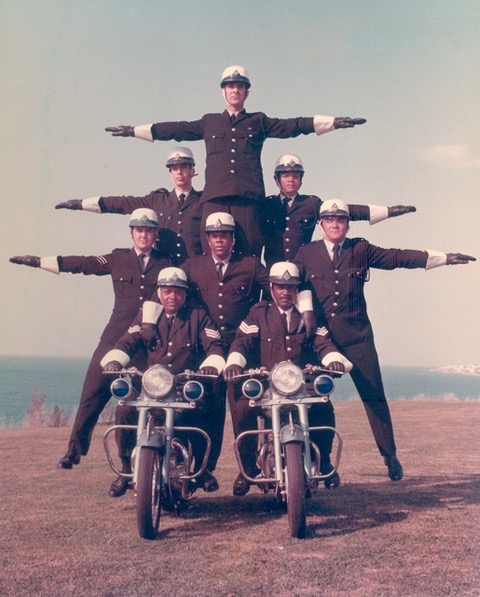 Police Motor Cycle Display Team perform the Pyramid
Police Motor Cycle Display Team perform the PyramidTom Cassin
Dennis Brookes and Erskine Warner
Harold Moniz, Campbell Simons and Eddie "Boxhead" Foggo
Custerfield "Custy" Crockwell and Gerald "Gerry" James
CLICK HERE to view our article on the History of the Police Motor Cycle Display Team written by Sgt George Goddard.

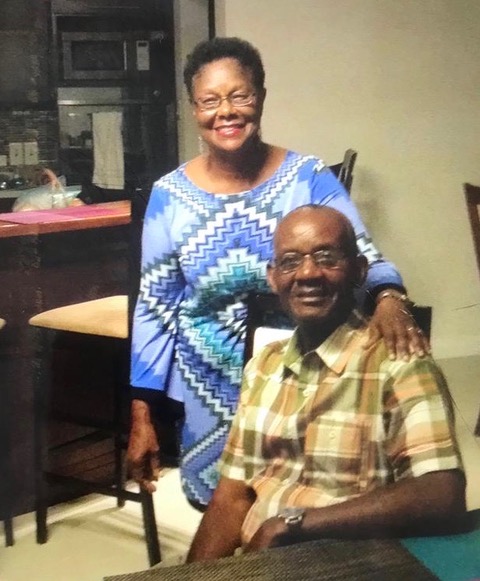





 After joining the Bermuda Police in 1966 as the first contingent from Barbados
After joining the Bermuda Police in 1966 as the first contingent from Barbados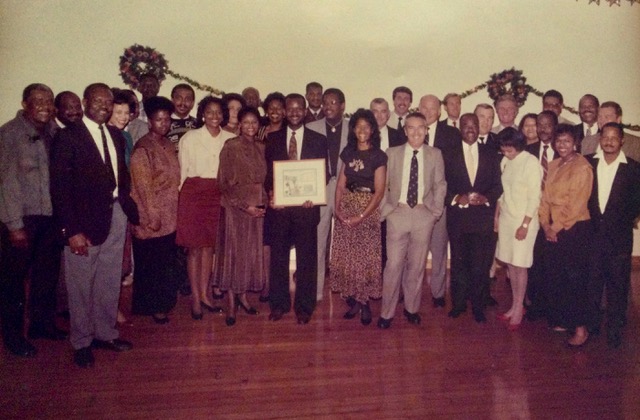


 The Daisley's Garden 2 weeks after La Soufriere volcano
The Daisley's Garden 2 weeks after La Soufriere volcano 

 A very happy and smiling Orson with members and friends of the Barbados Team
A very happy and smiling Orson with members and friends of the Barbados Team Orson with his much loved Jack Russell "Missy"
Orson with his much loved Jack Russell "Missy"
